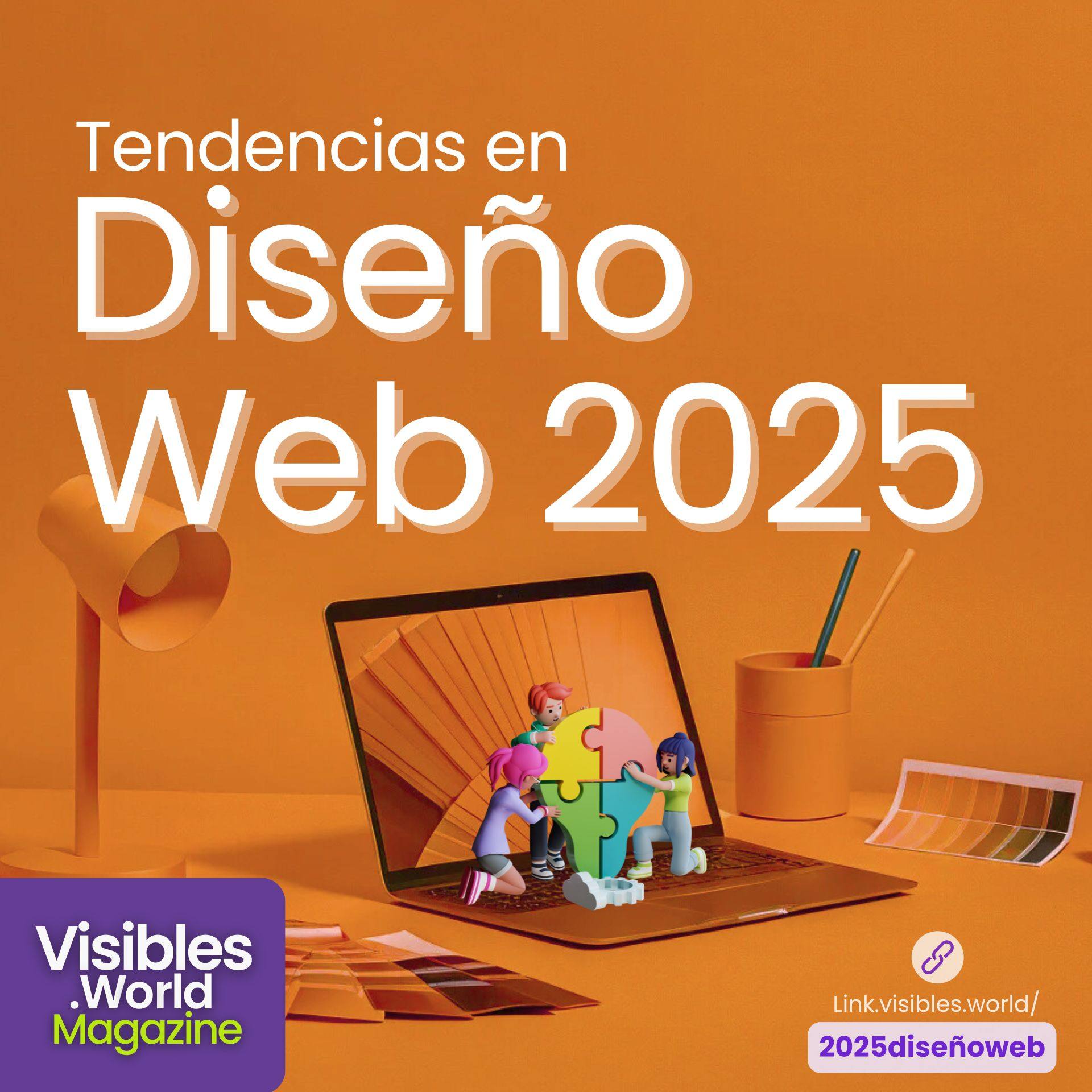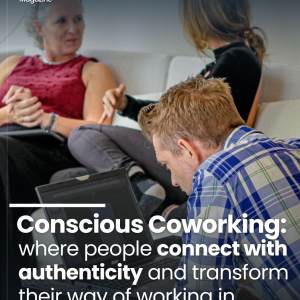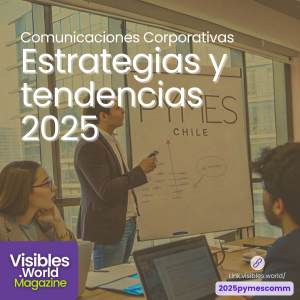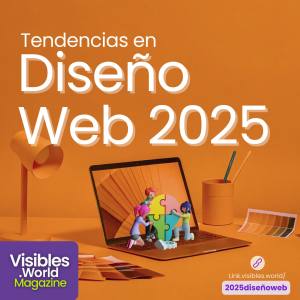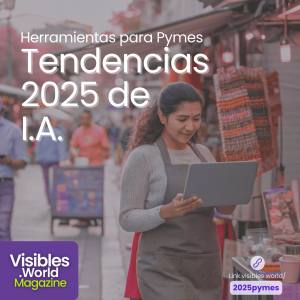Web Design Trends for 2025: Innovations and Styles That Will Make a Difference
Trends are constantly evolving and go according to cultural and social changes; therefore, in web design services, they are also adapting not only in terms of new technologies but also the forms of communication and objectives that prioritize the user experience. Today we will explore the most important innovations in web design, from our perspective as a communications agency for 2025, which will not only influence aesthetics, but could also collaborate to improve the profitability of service providers such as entrepreneurs and SMEs.
Table of Contents
- Introduction to Web Design Trends
- Dynamism and Asymmetry: Breaking the Traditional Symmetry
- Grid Event: The New Dynamic Structure
- Nostalgic Retro Design: A Journey to the Past
- Vibrant Gradients: Colors that Make an Impact
- Giant Typography: The Power of Words
- Conclusions and Final Thoughts
- Frequently Asked Questions
Introduction to Web Design Trends
Web design is an ever-changing field, where trends emerge and evolve, shaping the way we connect and communicate in the digital world. Looking ahead to 2025, it is vital to understand what trends will set the tone. From dynamic structures to vibrant color palettes, every element plays a crucial role in the user experience.
The emotional and visual connection that a website can establish with its audience is fundamental. In this context, every detail counts: from the typography to the layout of the elements on the page. The goal is not only to capture attention, but also to generate a memorable experience that invites interaction.
Grid Element: The New Dynamic Structure
One of the most notable trends emerging for the future is the Event Grid. This design approach is based on a modular structure that allows for a clear and organized presentation of content. Imagine having different 'little boxes' that adapt and reorganize according to the size of the screen, allowing information to flow naturally.
The Evento Grid is not only about aesthetics, but also about functionality. By using tools such as CSS Grid or Flexbox, designers can create layouts that perfectly fit the user's needs. This results in more intuitive navigation and an optimized user experience. In the end, it's all about displaying a lot of content in an accessible way, preventing the user from feeling overwhelmed.
In addition, this approach aligns with the growing demand for content in a world where information is consumed at an accelerated pace. The ability to present multiple elements at a glance makes it easier for users to choose what to explore, making their experience more efficient and enjoyable.
Nostalgic Retro Design: A Journey to the Past
Nostalgic retro design is a trend that evokes memories and emotions, transporting users back in time. This aesthetic is not only visually appealing, but also has the power to connect on an emotional level. It uses desaturated colors, peculiar typography and visual elements reminiscent of the analog devices of yesteryear.
In this style, borders are sharp and icons, reminiscent of bygone eras, play a crucial role. Mixing visual elements that evoke nostalgia can make a website memorable and unique. In addition, using hand-drawn illustrations brings a dose of originality that is a departure from the generic designs that flood the web today.
It is important to remember that while this trend can be very appealing, it must be applied with care. The target audience must be considered to ensure that the design resonates with them. For example, a website for lawyers might not benefit from such a playful approach. The key is to find the right balance between nostalgia and professionalism.
Vibrant Gradients: Colors that Make an Impact
Vibrant gradients are gaining traction as one of the most exciting design trends for 2025. This technique uses bold color combinations that not only attract attention, but can also communicate the essence of a brand effectively. Imagine a background that flows from one color to another, creating a visually stimulating atmosphere.
The versatility of gradients allows their use in both dark and light modes, each achieving a different but equally professional effect. By applying this technique, a minimalist design can be maintained, focusing on colors and typography, rather than saturated images. This results in a clearer and more elegant presentation.
However, when working with vibrant colors, it is essential to keep in mind the harmony of the palette. Using complementary colors without falling into combinations that result in dirty or unattractive tones is crucial. A useful tip is to incorporate a bridging color to ease the transition between shades, ensuring that the end result is visually pleasing.
- The modular structure of the Evento Grid allows for intuitive navigation.
- The nostalgic retro design evokes emotions and memories, creating a unique connection with users.
- Vibrant gradients attract attention and facilitate a minimalist design.
- The choice of colors should consider harmony and legibility.
- It is essential to adapt the design to the target audience to ensure effectiveness.
If you want to dive deeper into how these trends can transform your digital presence, don't hesitate to contact us for a design consultancy. We are here to help you shine in the digital world.
Dynamism and Asymmetry: Breaking Traditional Symmetry
Web design has begun to move away from traditional symmetry, seeking a more dynamic and asymmetrical aesthetic. This trend invites designers to experiment with the arrangement of elements, creating a sense of movement and fluidity on the page. By breaking the symmetry, the user's attention is captured more effectively, making each visit a unique experience.
Asymmetry is not only visually appealing, but also allows for better organization of content. Imagine a page that uses different sizes and positions for elements: some larger and more prominent, others smaller and more subtle. This approach helps direct the user's eye to what really matters, making navigation and interaction easier.
In addition, combining asymmetrical elements can result in a more authentic and personalized design. Companies can reflect their brand identity through this aesthetic, presenting their content in a way that resonates with their audience. However, it is crucial to strike a balance; too much asymmetry can be confusing. The key is to use asymmetry strategically, ensuring that the most important information remains accessible and easy to find.
Giant Typography: The Power of Words
Giant typography has become one of the most impactful trends in web design. This technique focuses on using large fonts to convey messages in a clear and powerful way. By opting for large typefaces, designers can communicate the essence of a brand without the need for complex or elaborate imagery.
The use of giant typography is not only eye-catching, but also allows for better legibility. In a world where user attention is fleeting, this strategy ensures that key messages are seen and understood immediately. In addition, typography can be used as a visual element in its own right, transforming text into a work of art that draws the eye.
However, it is important to keep context and audience in mind when implementing this trend. Giant typography may be ideal for advertising campaigns, landing pages or creative websites, but it may not be suitable for all types of content. The choice of font and its size should align with the brand identity and the message you want to convey.
Conclusions and Final Thoughts
As we move into 2025, web design trends will continue to evolve, challenging established norms and seeking new ways to connect with users. From dynamism and asymmetry to bold use of typography, each trend offers unique opportunities to enhance the user experience and stand out in a crowded digital environment.
It is essential that designers stay on top of these trends and experiment with them, adapting them to the needs of their clients and audience. Creativity and innovation will be key to creating websites that are not only visually appealing, but also offer a memorable user experience.
We invite anyone interested in boosting their digital presence to contact us for a design consultancy. Together, we can explore how these trends can be integrated into your digital strategy and help you stand out in the online world.
The trend of artificial intelligence in web design is rapidly gaining ground, offering automated tools that promise to simplify the site creation process. Implementing automated software to generate websites can be tempting, especially for those looking for quick and inexpensive solutions. However, it is crucial to consider the advantages of having the advice of a communications expert, a graphic designer and a web design specialist. While automated systems can facilitate the production of a site, they often lack the ability to understand the subtleties of branding, visual storytelling and user experience that trained professionals can offer.
Experts bring a customized approach, analyzing the specific audience and tailoring each design element to maximize the emotional connection and functionality of the site. In addition, human creativity allows for the creation of unique and differentiating solutions, which are difficult to replicate with automated tools that often rely on predefined templates and configurations. Ultimately, investing in a multidisciplinary team may prove more valuable in the long run, ensuring that the website is not only visually appealing, but also effective in meeting business objectives and providing a memorable user experience.
The evolution of local search and the integration of technologies such as ChatGPT Search and other artificial intelligence applications have significantly transformed the digital landscape. In recent years, we have witnessed search evolve from mere text queries to more complex and personalized interactions. This evolution not only enhances the user experience, but also redefines how businesses present themselves in the digital environment.
With the rise of voice search and artificial intelligence, consumers now expect quick and relevant responses based on location and context. As a result, companies must adapt their communication and marketing strategies to take advantage of these new tools. Here are five key tips for large enterprises to consider when implementing local search and AI technologies:
- Optimize content for voice search: make sure your content is optimized for direct queries and natural language, as many searches are conducted through voice assistants. This includes using conversational phrases and answering common user questions.
- Improve your Google My Business presence: Keep your Google My Business profile information up to date and complete. This is crucial for local searches and helps make your business easily accessible to consumers searching for products or services in your area.
- Incorporate structured data: Use structured data on your website to help search engines better understand your content. This can improve your site's presentation in search results and increase local visibility.
- Monitor and respond to reviews: Online reputation is vital. Responding to reviews, both positive and negative, can improve customer perception and foster loyalty. In addition, reviews influence local search rankings.
- Implement chatbots and AI-powered user interfaces: Use chatbots to interact with your site visitors in real time. This not only improves the customer experience, but also helps gather data on user preferences and common queries, which can guide future content strategies.
By integrating these practices into your design and communication strategy, your company will not only be able to adapt to new trends, but will also be better positioned to connect with your audience more effectively.
Creating authentic content is crucial in a digital environment where information saturation can lead to confusion. Authenticity not only helps build a genuine connection with the audience, but is also a determining factor in brand reputation. As search engines evolve, they become more sophisticated in identifying quality and relevant content, favoring those sites that offer verified and original information over those that rely on AI-generated content, which can be considered "fake". This trend towards authenticity translates into greater consumer trust and, ultimately, better performance in terms of SEO. Therefore, brands must prioritize creating content that reflects their values and resonates with their audience, ensuring that their online presence is not only visible, but also trustworthy.
Graphic design is an essential discipline in the digital realm, as it focuses not only on aesthetics, but also on the effective communication of a message. Image quality plays a crucial role in this process, as a good visual presentation can capture the user's attention and improve brand perception. It is essential that the images used in a design are high resolution and optimized for the web, ensuring that they look sharp and professional on all devices.
In addition, having the oversight of a communications and graphic design consultant can make all the difference. These experts not only have a trained eye for identifying details that can enhance the design, but also understand how each visual element can influence the user experience. Their expertise allows them to select images that are not only visually appealing, but also effectively communicate the essence of the brand. Therefore, investing in a consultant can be key to ensuring that every aspect of the design is aligned with the communication objectives and brand identity.
-
As we approach 2025, SEO and local SEO trends are evolving significantly, driven by changes in consumer behavior, especially among Generation Z. This generation, who have grown up in a digital environment, are looking for quick and accessible information, which has led to an increase in the use of voice assistants such as Google and Alexa. These devices are transforming the way users interact with technology, favoring natural language queries and direct questions. Therefore, optimizing content for voice search becomes crucial to capture the attention of this audience.
In addition, Generation Z tends to use social networks such as Instagram, TikTok and other platforms to discover content. This means that SEO strategies must adapt to reflect the content on these platforms, ensuring that brands are where their audience is actively seeking information. By creating authentic and visually engaging content, companies can better connect with this generation and improve their online visibility.
In a world where information is consumed quickly, brands must be prepared to offer effective and relevant responses. This implies not only having a good positioning in search engines, but also in social networks and voice assistants. Companies that implement these strategies will be better positioned to attract and retain Generation Z, ensuring their relevance in an ever-changing market.
Integrating AI into Web Design: Artificial intelligence is becoming an invaluable tool in the field of web design. From personalizing the user experience to optimizing content, AI allows designers to create more effective sites tailored to the individual needs of users. Tools such as chatbots and virtual assistants enhance interaction and provide real-time support, which elevates customer satisfaction.
Microinteractions: Microinteractions, those small details that improve usability, will be more present in designs. These can include subtle animations, color changes or feedback messages that respond to user action. By implementing microinteractions, designers not only make the site more engaging, but also guide users through their experience, making them feel more connected to the content.
Inclusive and Accessible Design: As awareness of accessibility increases, designers are prioritizing the creation of websites that are inclusive for all users, regardless of their abilities. This involves considering aspects such as color contrast, easy navigation and the use of alternative text for images. An accessible design not only benefits people with disabilities, but also improves the overall user experience.
Animations and Smooth Transitions: Animations and transitions are evolving to be smoother and more natural, contributing to a more cohesive user experience. The use of animations can help tell a visual story, making the content easier to understand and maintaining user interest. However, it is important to apply these animations sparingly so as not to distract the user from crucial information.
Optimization for Mobile Devices: With an increasing number of users accessing the Internet through mobile devices, mobile optimization will continue to be a priority. This means creating responsive designs that adapt to different screen sizes and offer smooth navigation. Mobile usability not only improves the user experience, but also influences a website's SEO ranking.
Frequently Asked Questions
To close this analysis on web design trends, here are some frequently asked questions that may arise:
- How can I adapt my website to these trends? The key is to work with a designer who understands these trends and can implement them effectively on your site.
- Are these trends suitable for all types of businesses? Not necessarily. It's important to consider the nature of your business and your audience when choosing which trends to implement.
- How do these trends affect the user experience? By using these trends strategically, you can improve usability and user interaction, making the user experience more enjoyable and effective.
- Should I invest in a complete redesign? It is not always necessary. Sometimes small updates can have a big impact on the look and functionality of your site.
- Where can I find inspiration for my web design? Sites like Pinterest, Behance and Dribbble are great resources to find inspiration and see how other designers are implementing these trends.
For more information and advice on web design, feel free to contact us. We are here to help you transform your ideas into digital realities.
- Astrology for the Development of your Company / SME: Power your professional life.
- Inspirational stories of entrepreneurs.
- News about scientific societies and their impact.
- Trends and strategies for growing companies.
- Design and digital marketing services.
- Visibles World's portfolio of creative work and projects.
- Event coverage through professional photography.
- Barrio Italia TV: Entrepreneurship and gastronomy in Santiago.
- The importance of the 12 astrological houses and your role as an entrepreneur.
Trends are constantly evolving and go according to cultural and social changes; therefore, in web design services, they are also adapting not only in terms of new technologies but also the forms of communication and objectives that prioritize the user experience. Today we will explore the most important innovations in web design, from our perspective as a communications agency for 2025, which will not only influence aesthetics, but could also collaborate to improve the profitability of service providers such as entrepreneurs and SMEs.
Table of Contents
- Introduction to Web Design Trends
- Dynamism and Asymmetry: Breaking the Traditional Symmetry
- Grid Event: The New Dynamic Structure
- Nostalgic Retro Design: A Journey to the Past
- Vibrant Gradients: Colors that Make an Impact
- Giant Typography: The Power of Words
- Conclusions and Final Thoughts
- Frequently Asked Questions
Introduction to Web Design Trends
Web design is an ever-changing field, where trends emerge and evolve, shaping the way we connect and communicate in the digital world. Looking ahead to 2025, it is vital to understand what trends will set the tone. From dynamic structures to vibrant color palettes, every element plays a crucial role in the user experience.
The emotional and visual connection that a website can establish with its audience is fundamental. In this context, every detail counts: from the typography to the layout of the elements on the page. The goal is not only to capture attention, but also to generate a memorable experience that invites interaction.
Grid Element: The New Dynamic Structure
One of the most notable trends emerging for the future is the Event Grid. This design approach is based on a modular structure that allows for a clear and organized presentation of content. Imagine having different 'little boxes' that adapt and reorganize according to the size of the screen, allowing information to flow naturally.
The Evento Grid is not only about aesthetics, but also about functionality. By using tools such as CSS Grid or Flexbox, designers can create layouts that perfectly fit the user's needs. This results in more intuitive navigation and an optimized user experience. In the end, it's all about displaying a lot of content in an accessible way, preventing the user from feeling overwhelmed.
In addition, this approach aligns with the growing demand for content in a world where information is consumed at an accelerated pace. The ability to present multiple elements at a glance makes it easier for users to choose what to explore, making their experience more efficient and enjoyable.
Nostalgic Retro Design: A Journey to the Past
Nostalgic retro design is a trend that evokes memories and emotions, transporting users back in time. This aesthetic is not only visually appealing, but also has the power to connect on an emotional level. It uses desaturated colors, peculiar typography and visual elements reminiscent of the analog devices of yesteryear.
In this style, borders are sharp and icons, reminiscent of bygone eras, play a crucial role. Mixing visual elements that evoke nostalgia can make a website memorable and unique. In addition, using hand-drawn illustrations brings a dose of originality that is a departure from the generic designs that flood the web today.
It is important to remember that while this trend can be very appealing, it must be applied with care. The target audience must be considered to ensure that the design resonates with them. For example, a website for lawyers might not benefit from such a playful approach. The key is to find the right balance between nostalgia and professionalism.
Vibrant Gradients: Colors that Make an Impact
Vibrant gradients are gaining traction as one of the most exciting design trends for 2025. This technique uses bold color combinations that not only attract attention, but can also communicate the essence of a brand effectively. Imagine a background that flows from one color to another, creating a visually stimulating atmosphere.
The versatility of gradients allows their use in both dark and light modes, each achieving a different but equally professional effect. By applying this technique, a minimalist design can be maintained, focusing on colors and typography, rather than saturated images. This results in a clearer and more elegant presentation.
However, when working with vibrant colors, it is essential to keep in mind the harmony of the palette. Using complementary colors without falling into combinations that result in dirty or unattractive tones is crucial. A useful tip is to incorporate a bridging color to ease the transition between shades, ensuring that the end result is visually pleasing.
- The modular structure of the Evento Grid allows for intuitive navigation.
- The nostalgic retro design evokes emotions and memories, creating a unique connection with users.
- Vibrant gradients attract attention and facilitate a minimalist design.
- The choice of colors should consider harmony and legibility.
- It is essential to adapt the design to the target audience to ensure effectiveness.
If you want to dive deeper into how these trends can transform your digital presence, don't hesitate to contact us for a design consultancy. We are here to help you shine in the digital world.
Dynamism and Asymmetry: Breaking Traditional Symmetry
Web design has begun to move away from traditional symmetry, seeking a more dynamic and asymmetrical aesthetic. This trend invites designers to experiment with the arrangement of elements, creating a sense of movement and fluidity on the page. By breaking the symmetry, the user's attention is captured more effectively, making each visit a unique experience.
Asymmetry is not only visually appealing, but also allows for better organization of content. Imagine a page that uses different sizes and positions for elements: some larger and more prominent, others smaller and more subtle. This approach helps direct the user's eye to what really matters, making navigation and interaction easier.
In addition, combining asymmetrical elements can result in a more authentic and personalized design. Companies can reflect their brand identity through this aesthetic, presenting their content in a way that resonates with their audience. However, it is crucial to strike a balance; too much asymmetry can be confusing. The key is to use asymmetry strategically, ensuring that the most important information remains accessible and easy to find.
Giant Typography: The Power of Words
Giant typography has become one of the most impactful trends in web design. This technique focuses on using large fonts to convey messages in a clear and powerful way. By opting for large typefaces, designers can communicate the essence of a brand without the need for complex or elaborate imagery.
The use of giant typography is not only eye-catching, but also allows for better legibility. In a world where user attention is fleeting, this strategy ensures that key messages are seen and understood immediately. In addition, typography can be used as a visual element in its own right, transforming text into a work of art that draws the eye.
However, it is important to keep context and audience in mind when implementing this trend. Giant typography may be ideal for advertising campaigns, landing pages or creative websites, but it may not be suitable for all types of content. The choice of font and its size should align with the brand identity and the message you want to convey.
Conclusions and Final Thoughts
As we move into 2025, web design trends will continue to evolve, challenging established norms and seeking new ways to connect with users. From dynamism and asymmetry to bold use of typography, each trend offers unique opportunities to enhance the user experience and stand out in a crowded digital environment.
It is essential that designers stay on top of these trends and experiment with them, adapting them to the needs of their clients and audience. Creativity and innovation will be key to creating websites that are not only visually appealing, but also offer a memorable user experience.
We invite anyone interested in boosting their digital presence to contact us for a design consultancy. Together, we can explore how these trends can be integrated into your digital strategy and help you stand out in the online world.
The trend of artificial intelligence in web design is rapidly gaining ground, offering automated tools that promise to simplify the site creation process. Implementing automated software to generate websites can be tempting, especially for those looking for quick and inexpensive solutions. However, it is crucial to consider the advantages of having the advice of a communications expert, a graphic designer and a web design specialist. While automated systems can facilitate the production of a site, they often lack the ability to understand the subtleties of branding, visual storytelling and user experience that trained professionals can offer.
Experts bring a customized approach, analyzing the specific audience and tailoring each design element to maximize the emotional connection and functionality of the site. In addition, human creativity allows for the creation of unique and differentiating solutions, which are difficult to replicate with automated tools that often rely on predefined templates and configurations. Ultimately, investing in a multidisciplinary team may prove more valuable in the long run, ensuring that the website is not only visually appealing, but also effective in meeting business objectives and providing a memorable user experience.
The evolution of local search and the integration of technologies such as ChatGPT Search and other artificial intelligence applications have significantly transformed the digital landscape. In recent years, we have witnessed search evolve from mere text queries to more complex and personalized interactions. This evolution not only enhances the user experience, but also redefines how businesses present themselves in the digital environment.
With the rise of voice search and artificial intelligence, consumers now expect quick and relevant responses based on location and context. As a result, companies must adapt their communication and marketing strategies to take advantage of these new tools. Here are five key tips for large enterprises to consider when implementing local search and AI technologies:
- Optimize content for voice search: make sure your content is optimized for direct queries and natural language, as many searches are conducted through voice assistants. This includes using conversational phrases and answering common user questions.
- Improve your Google My Business presence: Keep your Google My Business profile information up to date and complete. This is crucial for local searches and helps make your business easily accessible to consumers searching for products or services in your area.
- Incorporate structured data: Use structured data on your website to help search engines better understand your content. This can improve your site's presentation in search results and increase local visibility.
- Monitor and respond to reviews: Online reputation is vital. Responding to reviews, both positive and negative, can improve customer perception and foster loyalty. In addition, reviews influence local search rankings.
- Implement chatbots and AI-powered user interfaces: Use chatbots to interact with your site visitors in real time. This not only improves the customer experience, but also helps gather data on user preferences and common queries, which can guide future content strategies.
By integrating these practices into your design and communication strategy, your company will not only be able to adapt to new trends, but will also be better positioned to connect with your audience more effectively.
Creating authentic content is crucial in a digital environment where information saturation can lead to confusion. Authenticity not only helps build a genuine connection with the audience, but is also a determining factor in brand reputation. As search engines evolve, they become more sophisticated in identifying quality and relevant content, favoring those sites that offer verified and original information over those that rely on AI-generated content, which can be considered "fake". This trend towards authenticity translates into greater consumer trust and, ultimately, better performance in terms of SEO. Therefore, brands must prioritize creating content that reflects their values and resonates with their audience, ensuring that their online presence is not only visible, but also trustworthy.
Graphic design is an essential discipline in the digital realm, as it focuses not only on aesthetics, but also on the effective communication of a message. Image quality plays a crucial role in this process, as a good visual presentation can capture the user's attention and improve brand perception. It is essential that the images used in a design are high resolution and optimized for the web, ensuring that they look sharp and professional on all devices.
In addition, having the oversight of a communications and graphic design consultant can make all the difference. These experts not only have a trained eye for identifying details that can enhance the design, but also understand how each visual element can influence the user experience. Their expertise allows them to select images that are not only visually appealing, but also effectively communicate the essence of the brand. Therefore, investing in a consultant can be key to ensuring that every aspect of the design is aligned with the communication objectives and brand identity.
-
As we approach 2025, SEO and local SEO trends are evolving significantly, driven by changes in consumer behavior, especially among Generation Z. This generation, who have grown up in a digital environment, are looking for quick and accessible information, which has led to an increase in the use of voice assistants such as Google and Alexa. These devices are transforming the way users interact with technology, favoring natural language queries and direct questions. Therefore, optimizing content for voice search becomes crucial to capture the attention of this audience.
In addition, Generation Z tends to use social networks such as Instagram, TikTok and other platforms to discover content. This means that SEO strategies must adapt to reflect the content on these platforms, ensuring that brands are where their audience is actively seeking information. By creating authentic and visually engaging content, companies can better connect with this generation and improve their online visibility.
In a world where information is consumed quickly, brands must be prepared to offer effective and relevant responses. This implies not only having a good positioning in search engines, but also in social networks and voice assistants. Companies that implement these strategies will be better positioned to attract and retain Generation Z, ensuring their relevance in an ever-changing market.
Integrating AI into Web Design: Artificial intelligence is becoming an invaluable tool in the field of web design. From personalizing the user experience to optimizing content, AI allows designers to create more effective sites tailored to the individual needs of users. Tools such as chatbots and virtual assistants enhance interaction and provide real-time support, which elevates customer satisfaction.
Microinteractions: Microinteractions, those small details that improve usability, will be more present in designs. These can include subtle animations, color changes or feedback messages that respond to user action. By implementing microinteractions, designers not only make the site more engaging, but also guide users through their experience, making them feel more connected to the content.
Inclusive and Accessible Design: As awareness of accessibility increases, designers are prioritizing the creation of websites that are inclusive for all users, regardless of their abilities. This involves considering aspects such as color contrast, easy navigation and the use of alternative text for images. An accessible design not only benefits people with disabilities, but also improves the overall user experience.
Animations and Smooth Transitions: Animations and transitions are evolving to be smoother and more natural, contributing to a more cohesive user experience. The use of animations can help tell a visual story, making the content easier to understand and maintaining user interest. However, it is important to apply these animations sparingly so as not to distract the user from crucial information.
Optimization for Mobile Devices: With an increasing number of users accessing the Internet through mobile devices, mobile optimization will continue to be a priority. This means creating responsive designs that adapt to different screen sizes and offer smooth navigation. Mobile usability not only improves the user experience, but also influences a website's SEO ranking.
Frequently Asked Questions
To close this analysis on web design trends, here are some frequently asked questions that may arise:
- How can I adapt my website to these trends? The key is to work with a designer who understands these trends and can implement them effectively on your site.
- Are these trends suitable for all types of businesses? Not necessarily. It's important to consider the nature of your business and your audience when choosing which trends to implement.
- How do these trends affect the user experience? By using these trends strategically, you can improve usability and user interaction, making the user experience more enjoyable and effective.
- Should I invest in a complete redesign? It is not always necessary. Sometimes small updates can have a big impact on the look and functionality of your site.
- Where can I find inspiration for my web design? Sites like Pinterest, Behance and Dribbble are great resources to find inspiration and see how other designers are implementing these trends.
For more information and advice on web design, feel free to contact us. We are here to help you transform your ideas into digital realities.
- Astrology for the Development of your Company / SME: Power your professional life.
- Inspirational stories of entrepreneurs.
- News about scientific societies and their impact.
- Trends and strategies for growing companies.
- Design and digital marketing services.
- Visibles World's portfolio of creative work and projects.
- Event coverage through professional photography.
- Barrio Italia TV: Entrepreneurship and gastronomy in Santiago.
- The importance of the 12 astrological houses and your role as an entrepreneur.
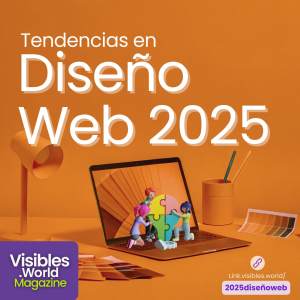

 ES
ES  EN
EN 